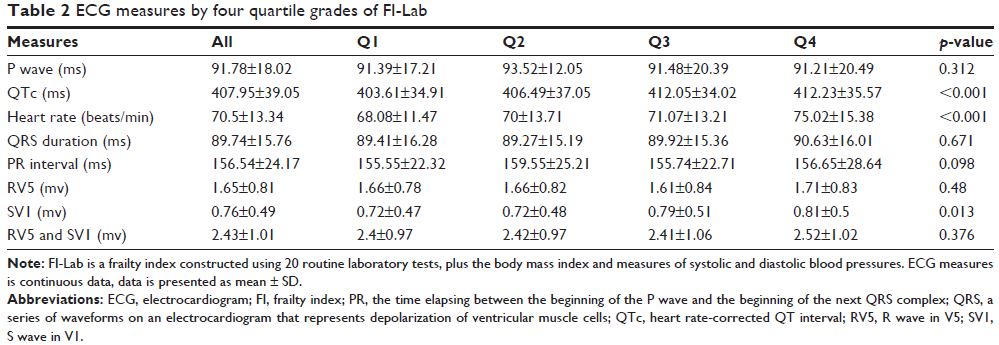108985
论文已发表
注册即可获取德孚的最新动态
IF 收录期刊
- 3.4 Breast Cancer (Dove Med Press)
- 3.2 Clin Epidemiol
- 2.6 Cancer Manag Res
- 2.9 Infect Drug Resist
- 3.7 Clin Interv Aging
- 5.1 Drug Des Dev Ther
- 3.1 Int J Chronic Obstr
- 6.6 Int J Nanomed
- 2.6 Int J Women's Health
- 2.9 Neuropsych Dis Treat
- 2.8 OncoTargets Ther
- 2.0 Patient Prefer Adher
- 2.2 Ther Clin Risk Manag
- 2.5 J Pain Res
- 3.0 Diabet Metab Synd Ob
- 3.2 Psychol Res Behav Ma
- 3.4 Nat Sci Sleep
- 1.8 Pharmgenomics Pers Med
- 2.0 Risk Manag Healthc Policy
- 4.1 J Inflamm Res
- 2.0 Int J Gen Med
- 3.4 J Hepatocell Carcinoma
- 3.0 J Asthma Allergy
- 2.2 Clin Cosmet Investig Dermatol
- 2.4 J Multidiscip Healthc

老年人常规实验室检查所得的虚弱指数与 QTc 延长之间的关联:如皋地区长寿现象与衰老研究
Authors Ma T, Cai J, Zhu Y, Chu X, Wang Y, Shi G, Wang Z, Yao S, Wang X, Jiang XY
Received 23 August 2017
Accepted for publication 19 February 2018
Published 27 April 2018 Volume 2018:13 Pages 797—804
DOI https://doi.org/10.2147/CIA.S149791
Checked for plagiarism Yes
Review by Single-blind
Peer reviewers approved by Dr Amy Norman
Peer reviewer comments 3
Editor who approved publication: Dr Wu
Background: Risk
factors for heart rate-corrected QT interval (QTc) proglongation should be
explored to stratify high-risk individuals to aid the prevention of incident
cardiovascular events and mortality. The diversity of risk factors for QTc
prolongation suggests that use of the frailty index (FI), indicating general
health deficits, may be an effective approach, especially in the elderly, to
identify the risk of QTc prolongation.
Methods: We used the data of 1,780 individuals aged 70–87 years from
the Rugao Longevity and Ageing Study (RuLAS), a community-based longitudinal
study. The FI was constructed using 20 routine laboratory tests, plus the body
mass index and measures of systolic and diastolic blood pressures (FI-Lab).
Results: The mean FI-Lab value was 0.24±0.09. The mean heart rate-corrected
QT interval (QTc) was 407±38 ms. The prevalence of QTc prolongation was
5.2% in elderly community populations aged 70–87 years. A higher FI-Lab
value was associated with a higher risk for QTc prolongation. Each 10% increase
in the FI-Lab value increased the odds ratio (OR) by 33% (OR: 1.33; 95% CI:
1.07–1.64). Compared with the lowest quartile, the top quartile FI-Lab score
was associated with a 2.50-fold QTc prolongation risk in elderly individuals
(95% CI: 1.21–5.19).
Conclusion: An FI based on routine laboratory data can identify older adults
at increased risk for QTc prolongation. The FI approach may therefore be useful
for the risk stratification of QTc prolongation.
Keywords: QTc prolongation, frailty, frailty index, Chinese elderly
